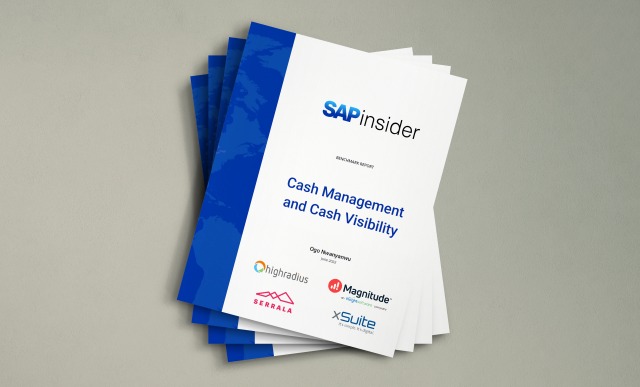Unlocking Global Visibility: Overcoming Cash and Treasury Challenges and Embracing Solutions
Meet the Authors
Key Takeaways
⇨ Nearly all organizations could stand to improve their global visibility of cash and liquidity.
⇨ Companies must prioritize automation and integration across finance components, especially in the domains of order-to-cash (O2C) and purchase-to-pay (P2P).
⇨ Third-party vendors help organizations realize significant ROI on SAP investments while accelerating time to value.
Finance and treasury teams face increased borrowing costs and liquidity risks. This makes effective cash management critical for any organization to ensure smooth operations, meet financial obligations, and sustain growth. Managing cash as an asset is a priority and the ability to see it at a global level is necessary for making informed business decisions
However, preliminary data from SAPinsider research on cash management and visibility reveals that a staggering 95% of respondent organizations lack global visibility of cash and liquidity. This means that nearly all organizations struggle to get a complete picture of their cash position, hindering their ability to make informed decisions and optimize their resources. The research suggests the disconnect is attributed to persistent core barriers that plague SAPinsiders. These barriers include manual non-integrated systems, over-reliance on customized cash management processes, and inadequate data quality and integration.
Report Highlights
In this article, we touch on a few preliminary insights from the upcoming Cash Management and Visibility Benchmark Report. In the report, we explore the challenges facing SAPinsiders in attaining global visibility. We also share the vendors SAPinsiders most frequently consider to bridge gaps in visibility and achieve their cash management goals.
Explore related questions
Operating in multiple countries and regions makes it challenging to consolidate financial data across source systems while navigating different currencies, tax laws, and banking formats. This complexity contributes to the lack of global cash visibility acknowledged by respondent organizations and impedes cash management
The preliminary findings highlight core challenges that create barriers for organizations struggling to realize global cash visibility:
- Manual, non-integrated systems and departmental silos: Outdated systems and disjointed workflows impede the efficient exchange of information needed for real-time cash visibility
- Complexity of customization: Organizations that rely heavily on tailored cash management processes find it challenging to standardize solutions. This makes it difficult to implement updates and additional functionality
- Inadequate data: Subpar data quality, integration, and availability hinder organizations from utilizing real-time analytics for cash visibility, a crucial factor in informed decision-making
Solutions
To achieve global cash visibility, organizations must prioritize automation and integration across finance components, especially in the domains of order-to-cash (O2C) and procure-to-pay (P2P). These areas play a vital role in attaining visibility. Furthermore, enhancing credit management, collection management, bank connectivity, and liquidity management processes contribute to the overall goal.
A comprehensive view of cash and liquidity across the entire organization requires a central system that consolidates all financial data from different business units, subsidiaries, and banks into a single platform. It also requires a strategic approach that includes process optimization, data integration, and automation. One survey respondent noted that their priority was to “have all the data in SAP and not keep any of it offline in spreadsheets.”
To enable this approach, SAPinsiders are increasingly considering cloud deployments for SAP S/4HANA Finance as an enterprise transformation starting with core finance operations. As such, preliminary data suggests most respondent organizations are evaluating RISE with SAP or GROW with SAP to enable this journey. These comprehensive offerings provide organizations with the tools and capabilities to transform their cash management and treasury functions.
Strategies
SAP solutions offer broad functionality for effective global finance management, yet as the world becomes more digital and data-driven there is room for enhancement of key cash management and treasury processes. Preliminary research insights highlight multiple strategies SAPinsiders are pursuing to address global cash visibility gaps, including:
- Leveraging advanced reporting tools: The effective use of advanced reporting tools can enhance the collection and analysis of financial data, thus improving cash visibility.
- Eliminating information and data silos: Encouraging the breakdown of silos and system integration fosters seamless data exchange, which is vital for real-time cash visibility.
- Exploring AI-based tools and functions: The utilization of AI-enabled solutions can automate manual tasks, improve accuracy, and provide new insights to enhance cash visibility.
- Adopting third-party cloud solutions: Utilizing cloud-based platforms offers real-time data access and analytics, facilitating timely cash management decisions
Another popular priority emerging from the research is the desire to collaborate with vendor partners, especially those with SAP Solution Extensions or SAP-certified solutions. These partners help organizations realize significant ROI on SAP investments while accelerating time to value. The vendors cited multiple times by survey respondents as being key to their cash management strategies include BlackLine, Delego, HighRadius, iCertis, insightsoftware, Kyriba, OpenText, Serrala, Tipalti, TruQua, and xSuite.
Conclusion
The evolving solutions from SAP and certified partners provide innovative ways to transform cash management and treasury functions. While achieving global visibility of cash and liquidity may remain an aspiration for many organizations, embracing automation and integration within finance processes is crucial to realizing that goal. Bridging the gap between desire and implementation unlocks the benefits of global visibility, optimizing financial operations and driving sustainable growth




